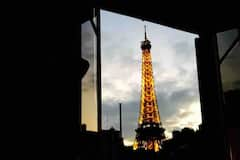Truly, this is the question probably rightfully asked by most people visiting this marvellous establishment. Try, just for a moment, to put aside the fact that various prominent people that left a mark in history are buried here, and then look around. You’ll see numerous splendid works of art adorning the graves of Pere Lachaise that even famous Parisian museums wouldn’t be ashamed of. And, an equally good part of this open-air museum is that it is completely free. You might only need a small effort to reach it because it is a bit sidelined from main tourist paths of Paris (it’s located in the 20th district of Paris), but it’s really worth it. Especially during spring, when its English-style garden environment is in full bloom.
How Pere Lachaise became one of the most prestigious burial places?

Pere Lachaise cemetery is located on the hill where King Louis XIV’s confessor (known as Father – Pere - Francois de la Chaise) used to live. In 1803, Napoleon Bonaparte purchased the land and turned it into a cemetery the following year. The introductory years of the new graveyard were overly disappointing due to its remoteness from Paris – only a couple of burials took place here. Then, the administration came up with, as it turned out, an excellent solution. The remains of de la Fontaine (the 17th century poet) and Moliere (a comedy writer and actor) were transferred to Pere Lachaise, followed by other similar acquisitions. In no time, the cemetery became a prestigious burial place, attracting people to secure their resting place next to the famous personalities. The once rusty cemetery was expanded several times until 1850.
Since the demand overly surpassed the offer, the price had risen, making the burial available only for the rich. However, being buried here wasn’t enough anymore. Members of the upper social classes started to compete who can make prettier and more opulent tombstone for their deceased. And, not only the tombstone, as you are about to find out.
Tombstones, sculptures, grottos… even houses!!!

While making your way lengthwise and crosswise through Pere Lachaise, you’ll see various motifs decorating tombs, family mausoleums and memorials. Some of them illustrate heavenly creatures and biblical scenes, such as angels, nymphs, shepherds with lambs (probably symbolizing the crucifixion of Christ), etc. Next to one another, you’ll see a statue of a female person holding a laurel wreath (clearly symbolizing victory), an obelisk, a Gothic chapel, and so on.
The differences of styles aren’t the only thing that appeals to a visitor while walking the Pere Lachaise’s expansive grounds. Since the cemetery is pretty much crowded, it often appears that the tombs and mausoleums are literally placed atop one another, making the place a bit charming, cemetery or no cemetery.
Graves of famous people and memorials of Pere Lachaise

Famous personalities with the eternal resting places on Pere Lachaise are numerous. Every one of them either lived in Paris, or was drawn to it at some point in their lives. It’s why various worldwide famous artists, scientists, politicians, writers, musicians and other performers are buried here. Since the deceased were buried where it was possible at the time of their deaths, their graves are scattered throughout the cemetery.
Among others, here are buried Edith Piaf, a singer, Frederic Chopin, a composer, writers Honore de Balzac and Oscar Wilde, artists Delacroix, Modigliani and Pissarro, famous dancer Jane Avril who performed at the Moulin Rouge, Jim Morrison, another singer, etc.
Beautiful memorials are devoted, in general, to civil and military victims of the 20th century World Wars. The one in the photo commemorates the Italian volunteers that died on the French soil in the First World War (1914 – 1918). Other memorials honour the Greeks, whose memorial is recognizable by the statue of the Winged Victory of Samothrace, the Czechoslovakian victims and the Russians, to mention some. A memorial devoted to the French Jews taken to the German death camps during the Second World War is also present.
You might be interested in these Airbnbs!
Useful information
Opening times of the Pere Lachaise cemetery depend on the season and a day, but, in general, are between 08:30 and 17:30. A quick visit could be squeezed in two hours, while a lengthy one could be stretched a full day. The brochures offering a basic info are available at the entry points. However, if you are still unable to manage, you can hire a local (at the entrance) that will help you navigate throughout the cemetery.
History
Get Trip101 in your inbox
Unsubscribe in one click. See our Privacy Policy for more information on how we use your data






















Create an account to